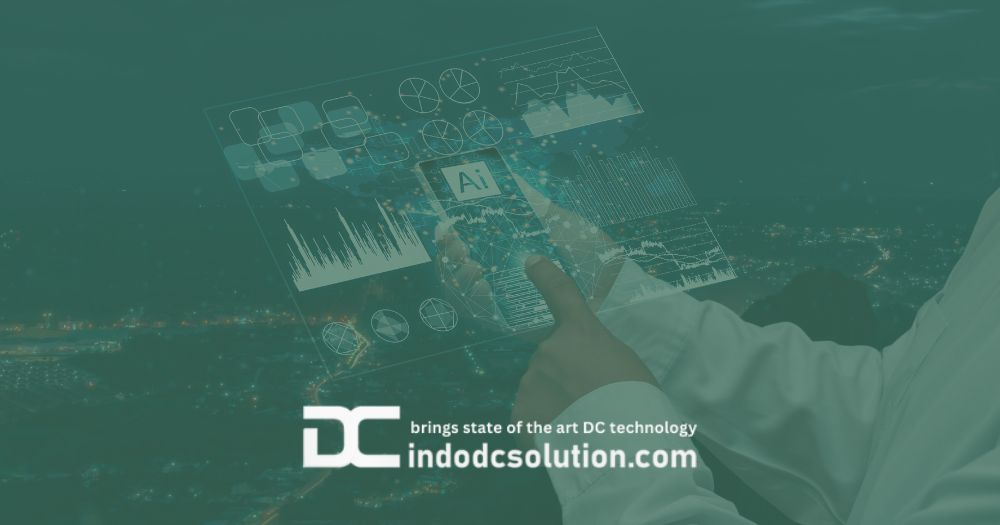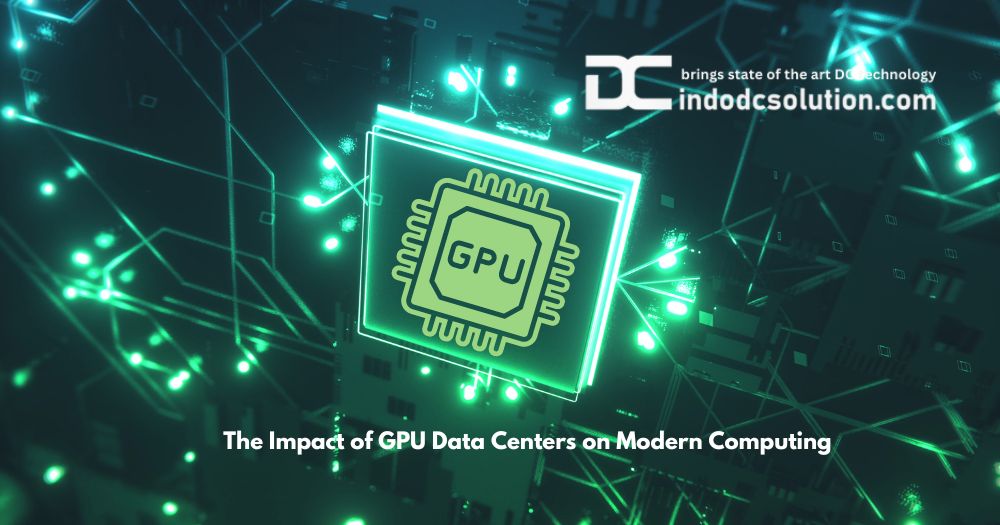In today’s digital era, the demand for faster and more efficient computing systems has never been more critical. With the rise of big data, artificial intelligence (AI), and machine learning (ML), traditional central processing unit (CPU) technology has reached its limits, prompting the need for alternative solutions. This is where GPU data centers come into play, revolutionizing the world of modern computing.
Understanding GPU Data Centers
Before delving into the impact of GPU data centers, it is crucial to grasp the concept itself. GPU, short for Graphics Processing Unit, was originally designed for image rendering and video games.
However, its parallel processing capabilities make it a game-changer in the world of computing. GPU data centers harness the power of these specialized processors to tackle complex computational tasks, providing a groundbreaking solution for a wide range of industries.
GPU data centers have revolutionized the way organizations handle data-intensive processes. By leveraging the parallel processing power of GPUs, these centers can accelerate tasks that would traditionally take much longer on a CPU-based system. This efficiency has opened up new possibilities in fields such as machine learning, scientific research, and financial modeling.
Defining GPU Data Centers
A GPU data center refers to a facility dedicated to housing and operating numerous GPUs for high-performance computing. These centers are equipped with specialized cooling systems and power supplies to ensure optimal performance while minimizing energy consumption.
The design of GPU data centers is meticulously planned to meet the unique requirements of these powerful processors. Data center racks, cooling systems, redundant power supplies, advanced networking infrastructure, and robust security measures all play a crucial role in safeguarding the valuable data processed within.
Evolution of GPU Data Centers
The development of GPU data centers is a testament to the continuous evolution of computing technology. Initially limited to gaming and graphics-intensive applications, GPUs have become increasingly popular in scientific research, data analysis, and AI-driven tasks.
The capabilities of GPU data centers have expanded exponentially, making them an integral part of modern computing infrastructure.
As the demand for high-performance computing continues to rise, GPU data centers are poised to play an even more significant role in shaping the future of technology.
The ongoing advancements in GPU architecture and the optimization of software for parallel processing ensure that these data centers will remain at the forefront of innovation, driving breakthroughs in various industries.
The Role of GPU Data Centers in Modern Computing
As technology advances, the need for high-performance computing becomes essential across various industries. GPU data centers offer numerous benefits, enabling organizations to harness the true potential of modern computing systems.
With the exponential growth of data and the increasing complexity of computational tasks, the role of GPU data centers in modern computing cannot be overstated. These specialized facilities house a vast array of graphics processing units (GPUs) that are specifically designed to handle parallel processing tasks with remarkable efficiency.
GPU Data Centers and High-Performance Computing
High-performance computing (HPC) requires immense computational power to process vast amounts of data in real-time. GPU data centers excel in this field by leveraging the parallel processing capabilities of GPUs.
With thousands of cores working simultaneously, GPU data centers significantly accelerate complex calculations, enabling breakthroughs in fields such as weather forecasting, genomics, and fluid dynamics.
Furthermore, GPU data centers are not only limited to traditional HPC applications but also play a crucial role in emerging technologies such as quantum computing and computational fluid dynamics. By harnessing the power of GPUs, researchers and scientists can explore new frontiers in scientific research and innovation.
GPU Data Centers in AI and Machine Learning
The advent of AI and ML brings about new challenges. These algorithms heavily rely on extensive data analysis and iterative calculations, demanding immense computational resources.
GPU data centers provide the necessary infrastructure to train and run complex models efficiently, enabling advancements in natural language processing, computer vision, and autonomous systems.
Moreover, the scalability and flexibility of GPU data centers make them ideal for handling the dynamic workloads of AI and ML applications.
By leveraging the parallel processing capabilities of GPUs, organizations can accelerate the development and deployment of cutting-edge AI solutions, driving innovation across various industries.
Advantages of GPU Data Centers
When employing GPU data centers, organizations can benefit from a multitude of advantages that traditional CPU-based systems simply cannot match.
One key advantage of GPU data centers is their ability to handle massive amounts of data with exceptional speed and efficiency.
The parallel architecture of GPUs allows for simultaneous execution of multiple tasks, enabling accelerated data processing capabilities. This speed not only enhances overall system performance but also enables organizations to analyze and derive insights from complex datasets in a fraction of the time it would take with CPU-based systems.
Speed and Efficiency in Data Processing
GPU data centers deliver significantly faster data processing speeds compared to CPUs. The parallel architecture of GPUs allows for simultaneous execution of multiple tasks, ensuring quick turnaround times for complex computations. This speed translates to faster data analysis, reduced time to market, and improved decision-making capabilities for businesses.
Moreover, the efficiency of GPU data centers extends beyond just processing speed. These centers are designed to handle high-performance computing workloads with optimal resource utilization, leading to enhanced operational efficiency. By harnessing the power of GPUs, organizations can streamline their data processing workflows and achieve greater productivity in data-driven tasks.
Energy Efficiency and Sustainability
Energy consumption is crucial for any data center. Compared to CPU-based data centers, GPU data centers offer superior energy efficiency.
Specialized cooling systems, data center racks, and optimized power supplies allow GPU data centers to process larger workloads while consuming less energy. This approach reduces operational costs and contributes to environmental sustainability.
Furthermore, the sustainability aspect of GPU data centers goes beyond energy efficiency. These centers are designed to be scalable and adaptable, allowing organizations to expand their computational capabilities without significantly increasing their environmental footprint.
When your busimess investing in GPU data centers, your business can align their technological advancements with eco-friendly practices, promoting a greener approach to data processing and analysis.
Challenges and Solutions in Implementing GPU Data Centers
While the advantages of GPU data centers are undeniable, their implementation comes with certain challenges that organizations need to address.
Implementing GPU data centers can revolutionize the way organizations process and analyze data, unlocking new possibilities for complex computational tasks.
Data centers can significantly boost performance by leveraging the parallel processing power of GPUs, leading to faster data processing and improved machine learning capabilities.
Addressing High Initial Investment Costs
Building a GPU data center requires a significant upfront investment. The cost of GPUs, cooling infrastructure, and power supplies can be substantial. However, organizations can mitigate these costs by considering cloud-based GPU data center solutions or exploring partnerships with specialized providers.
Additionally, the long-term benefits and potential cost savings offered by GPU data centers make them a worthwhile investment.
Furthermore, organizations can optimize their investment in GPU data centers by implementing efficient resource allocation strategies and workload scheduling techniques.
Organizations can improve the cost-efficiency of their data center operations by optimizing GPU resource usage and reducing idle time.
Overcoming Technical Limitations
Integrating GPU data centers into existing computing infrastructure may present technical hurdles such as software compatibility and system integration.
Organizations should collaborate closely with GPU vendors and software developers to ensure seamless integration and maximum performance.
Dedicated training and support can help teams navigate these technical challenges, ensuring a smooth transition to GPU-powered computing.
Moreover, organizations can leverage containerization technologies such as Docker and Kubernetes to streamline the deployment and management of GPU-accelerated applications within data center environments.
Organizations can achieve improved flexibility and scalability in managing GPU resources across diverse computing environments by packaging applications and their dependencies into portable containers.
The Future of GPU Data Centers

Looking ahead, GPU data centers are set to play an even more significant role in shaping the future of modern computing.
Emerging Trends in GPU Data Center Technology
Research and development in GPU technology continue to accelerate, enabling even more powerful and efficient GPU data centers.
Advancements such as increased memory bandwidth, improved interconnects, and enhanced high-density packaging are set to revolutionize the capabilities of GPU data centers, facilitating advancements in AI, ML, and other computationally demanding fields.
One of the emerging trends in GPU data center technology is the integration of artificial intelligence algorithms directly into the GPUs themselves.
This integration allows for real-time decision-making and analysis, reducing the need for data transfer between the GPU and the CPU. This not only improves the overall performance of the data center but also enables more complex and sophisticated AI applications.
Another exciting development in GPU data centers is the use of liquid cooling systems. As GPUs become more powerful, they generate a significant amount of heat, which can affect their performance.
Liquid cooling systems help dissipate this heat more efficiently, ensuring optimal performance and reducing the risk of overheating.
These innovative cooling solutions are paving the way for even denser GPU data centers, where more GPUs can be packed into a smaller space, further increasing computational power.
Predictions for GPU Data Centers in the Next Decade
Growing demand for AI, ML, and data-intensive applications will drive the proliferation of GPU data centers in the coming years. As GPU technology becomes more accessible and cost-effective, businesses and research institutions will increasingly adopt GPU data centers to gain a competitive edge.
The extensive adoption of these technologies will open doors to innovations in medical research, autonomous vehicles, financial modeling, and various other industries.
Moreover, with the rise of edge computing, GPU data centers are expected to be deployed closer to the source of data generation. This decentralization of computing power will enable faster processing and reduced latency, making it ideal for applications that require real-time decision-making, such as autonomous vehicles and smart cities.
The ability to process data locally will also alleviate the strain on network infrastructure, improving overall system efficiency.
In conclusion, GPU data centers have a profound impact on modern computing. Their parallel processing capabilities and unrivaled performance significantly enhance high-performance computing, AI, and data analysis.
As technology continues to evolve, GPU data centers will shape the future of computing, enabling groundbreaking advancements and fostering innovation across a wide range of industries.

